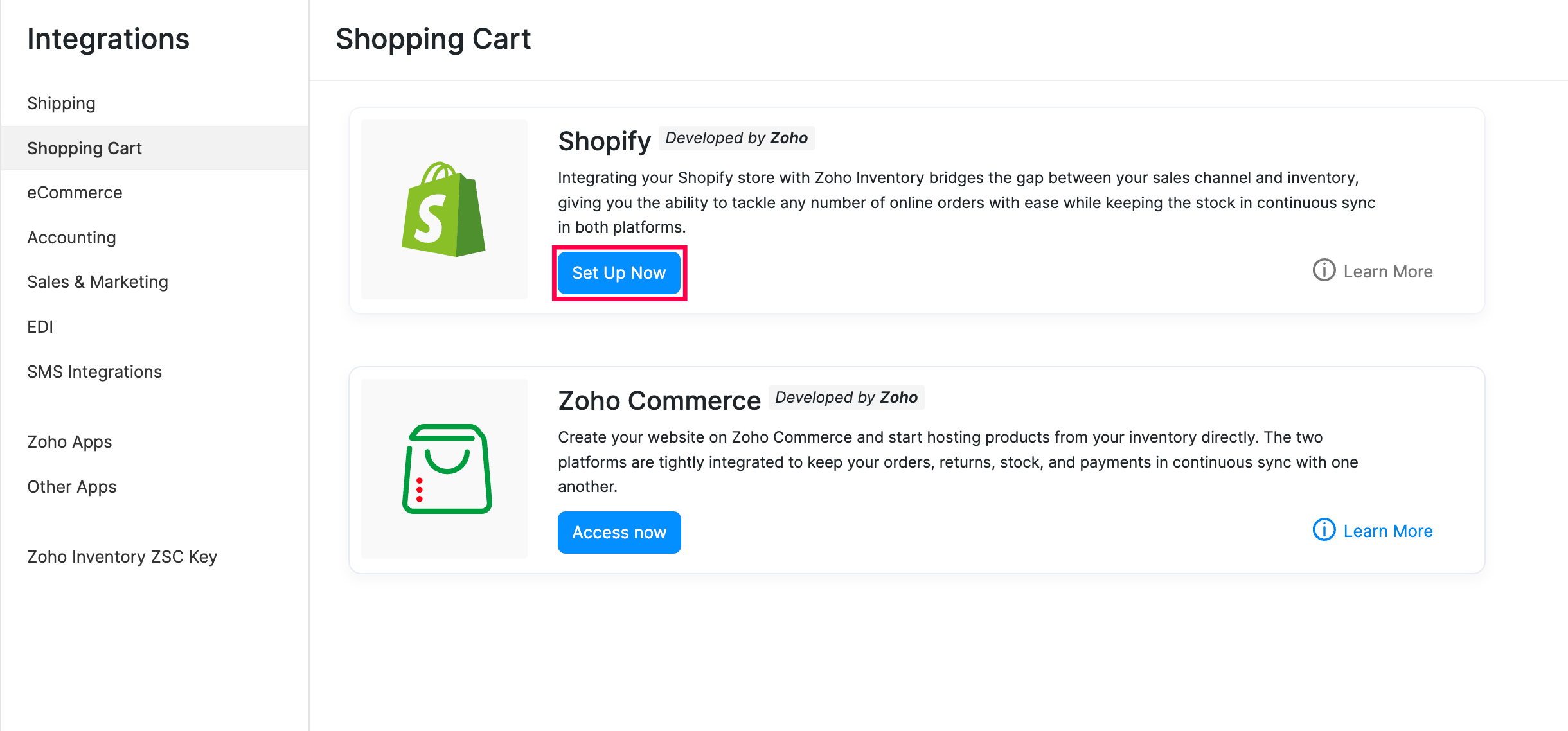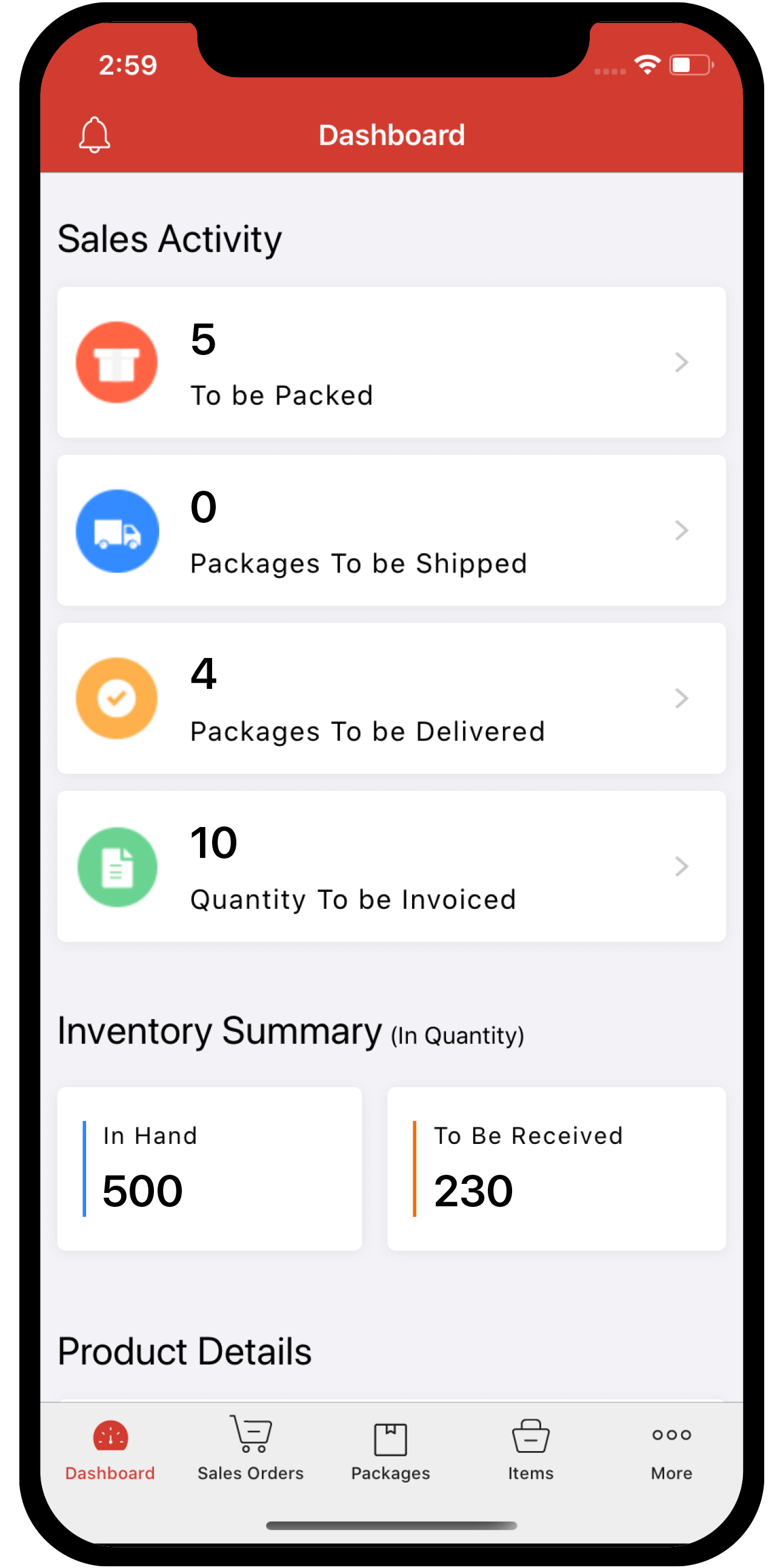 Inventory
Inventory
Integrate Zoho Inventory with Shopify
Shopify is a professional online storefront that can be set up in minutes. When integrated with Zoho Inventory, it enables seamless order management, payment processing, and real-time stock updates, ensuring a smooth e-commerce workflow.
IN THIS PAGE…
- Integrate with Shopify
- Configure Your Integration
- Set Up GST Rates in Shopify
- Add Tax Override
- Connect Multiple Stores
- Disable/Delete Store Integration
- Tune the Integration
- Sync History
- Re-Initiate a Sync
- Sync Orders and Items from a Custom Timeframe
- Export Sync History
- Re-authenticate the Integration
Integrate with Shopify
Note: Once the integration is complete, all orders from Shopify will automatically sync with Zoho Inventory.
To integrate your Shopify store with Zoho Inventory:
-
Go to Settings by clicking the Gear icon in the top right corner.
-
Select Shopping Cart under Integration & Marketplace.
-
Click Enable Online Sales to start accessing this feature.

-
Under Shopify, click Set Up Now. You’ll then be redirected to Shopify’s app store once you enter your store’s name.
-
Click Add App.
-
Select the store you want to link with your Inventory organization.
After you select your preferred store in Shopify, you’ll be redirected to Zoho Inventory’s connection page where you have to authorize the integration. Here’s how:
- On the connection page, click Connect Shopify.
- Then, click Connect Shopify next to the organization that you want to integrate with Shopify.
You’ve successfully integrated your Zoho Inventory organization with your Shopify store.
Configure Your Integration
Once you integrate your Shopify with Zoho Inventory, you can configure how and when you want the sync to happen
-
Go to Settings by clicking the Gear icon in the top right corner.
-
Select Shopping Cart under Integration & Marketplace.
-
Under Shopify, click Show Details near the store you want to configure
-
Click Configure in the top right corner

-
Select the Map Items dropdown to choose how you want the items to be mapped in Zoho Inventory.
-
Select a Tax Exemption which will be automatically applied to all the non-taxable items fetched from Shopify.
-
Enable Sync Stock to ensure regular updates of stock changes from Zoho Inventory to Shopify.
-
Enable Fetch Stock Counts to update your Shopify stock levels with Zoho Inventory. Note that this occurs only once during the initial sync.
-
In the Import From field, select the preferred date for the import to begin.
-
Select the Sync Frequency to specify how often the synchronisation should occur.
-
Choose a Customer Mapping preference:
- Single Customer: All Shopify orders will be tracked under one customer name for easier tracking.
- Custom: You can customise how you want the mapping to take place from Shopify.
-
Choose a Warehouse Mapping preference:
-
Single Warehouse: All the items will be tracked under the selected primary warehouse
-
Multiple Warehouse: You can map Zoho Inventory warehouses with Shopify Locations.
Set Up GST Rates in Shopify
Businesses based in India are required to register for GST if their annual turnover exceeds 20 lakhs in most states, and 10 lakhs in the North-Eastern states.
In your Shopify store, you can set the GST rates by going to Settings, then Taxes.
Note: If India is not listed under Tax Regions, you will have to add it first as a shipping zone. To add a shipping zone, go to Settings > Shipping > Shipping profiles > click Create New profile*.*
- The Country/Federal Tax (CGST) rate is initially set to 9%. Based on your state and the type of products you sell, you can set the CGST rate accordingly.
- For the state your business is based in, specify the SGST (or UTGST) rate and choose added to % federal tax from the drop-down.
- For other states, specify the IGST rate and choose instead of % federal tax from the dropdown.
For example, if your business is based in Tamil Nadu, where 18% GST is applicable:
- Set the CGST rate to 9%.
- For Tamil Nadu, 9% SGST rate and choose add to 9% federal tax from the dropdown.
- For all other states except union territories, enter 18% IGST rate and choose instead of 9% federal tax from the dropdown.
- For union territories, enter 9% UTGST rate and choose added to 9% federal tax from the drop-down.
Warning: Make sure to enter valid tax names. The values accepted are SGST, IGST and UTGST. Orders will fail to sync into Zoho Inventory if any other tax name is specified.
Add Tax Override
To apply a different tax rate to items of varying tax slabs, you can add tax overrides. When you add a tax override, the default tax rate gets discarded and the new rate is applied to the collection.
To add a tax override to the products in Shopify:
- Go to Setting by clicking the Gear icon in the top right corner.
- Click Taxes under Tax & Compliance.
- Click Edit next to India.
- Scroll down to Tax overrides and click Add a tax override.
- Choose Products and select a collection that needs an override.
- Select the location where you want the new rate to apply.
- Enter the new rate you want to charge for the products in the collection.
- Click Add Override.
To add a tax override to the shipping charges in Shopify,
- Go to Setting by clicking the Gear icon in the top right corner.
- Click Taxes under Tax & Compliance.
- Click Edit next to India.
- Scroll down to Tax overrides and click Add a tax override.
- Choose Shipping and select the location where you want the new rate to apply.
- Enter the new rate that you want to apply to the shipping charge.
- Click Add Override and click Save.
Whenever a Shopify order is received in Zoho Inventory,
- The customer is created either as a Consumer or as Overseas based on their shipping address.
- The Place of Supply is also obtained from the shipping address.
- A new tax from Shopify gets added as a tax group in Zoho Inventory.
Connect Multiple Stores
To connect multiple stores with your Zoho Inventory organization:
- Go to Settings by clicking the Gear icon in the top right corner.
- Select Shopping Cart under Integration & Marketplace.
- Enter your store’s name, and you’ll be redirected to Shopify’s app store.
- Click Add App.
- Select the store you want to link with your Inventory organization.
After you select your preferred store in Shopify, you’ll be redirected to Zoho Inventory’s connection page where you have to authorize the integration. Here’s how:
- On the Connection page, click Connect Shopify.
- Then, click Connect Shopify next to the organization that you want to integrate with Shopify.
You’ve successfully integrated your Zoho Inventory organization with your Shopify store.
Disable/Delete Store Integration
To remove or disable a store from your Shopify integration:
- Go to Settings by clicking the Gear icon in the top right corner.
- Select Shopping Cart under Integration & Marketplace.
- Under Shopify, click the Show Details link next to the store name that you want to remove.
- To put the integration on hold temporarily, click Disable Integration. This will show an Inactive status and stops the syncing between your Shopify store and Zoho Inventory.
- To remove the store integration, click Delete Integration.
- To reactivate the integration, click the Enable Integration button on the same page.
Tune the Integration
On successfully integrating your Shopify seller account with Zoho Inventory, you can now start tracking your inventory for every sale you make in Shopify.
For additional control over your integration:
- Go to Settings by clicking the Gear icon in the top right corner.
- Select Shopping Cart under Integration & Marketplace.
- Click Sync Manually next to Add Store.
- Choose one of the options between Items or Sales orders in the dropdown.
Note: Using the manual sync in one marketplace will trigger a sync to the other integrated marketplaces as well.
Sync History
The sync history page logs the periodic syncing of items and sales orders from the respective sales channels into Zoho Inventory. For each timestamp, you can view the number of items and sales orders that were successfully synced or had failed to sync into Zoho Inventory.
To view the sync history of a store:
- Go to Settings by clicking the Gear icon in the top right corner.
- Select Shopping Cart under Integration & Marketplace.
- Click the Overall Sync History icon in the top right corner.
Insight: The successfully synced record histories that are older than a month and failed sync histories that are older than two months will be deleted automatically.
Re-Initiate a Sync
You can also re-initiate a sync to once again fetch the items and sales orders that was brought into Zoho Inventory on a particular timestamp. This is beneficial when:
- An item or sales order had failed to sync into Zoho Inventory. By re-initiating the sync, the items that had failed to sync will be fetched.
- You have incorrectly linked an item from a sales channel to an existing item in Zoho Inventory. In such cases, you can unlink the items, make the necessary modifications, and re-sync the incorrectly mapped items.
To re-sync a task in Zoho Inventory:
-
Go to Settings by clicking the Gear icon in the top right corner.
-
Select Shopping Cart under Integration & Marketplace.
-
Click the Show details button on the store you want to re-sync.
-
Click the Overall Sync History icon in the top right corner.
-
Place your cursor over the task that you want to re-sync and click Re-sync.

The items and sales orders that were synced on the particular timestamp will be fetched once again into Zoho Inventory.
Sync Orders and Items from a Custom Timeframe
You can also resync orders and items from a custom date range from Shopify. To do so:
- Go to Settings by clicking the Gear icon in the top right corner.
- Select Shopping Cart under Integration & Marketplace.
- Under Shopify integration, click the Sync Manually button.
- Choose whether you want to sync Items or Orders from the dropdown.
- Choose the Specific Period option from the ‘Fetch records from’ dropdown.
- Select the Start Date and the End Date.
- Click Initiate Sync to pull your orders or items from Shopify.
Export Sync History
To export sync history:
- Go to Settings by clicking the Gear icon in the top right corner.
- Select Shopping Cart under Integration & Marketplace.
- Click the Show details button on the store you want to export.
- Go to the Overall Sync History icon in the top right corner.
- Click Export in the top right corner
- Choose your preferred options and click Export.
Re-authenticate the Integration
In case you have de-activated the integration from your Shopify store by removing Zoho Inventory as an associated app, you can re-enable this integration using the re-authenticate feature.
To re-authenticate the integration,
- Go to Settings by clicking the Gear icon in the top right corner.
- Select Shopping Cart under Integration & Marketplace.
- Click the Show Details near the preferred Shopify store, if you’ve integrated many stores.
- Click the dropdown button at the top right corner and click Reauthenticate.
- Enter your Shopify store credentials in the login page.
After evaluating your credentials, the Shopify store will be successfully reconnected to your Zoho Inventory organization. You will henceforth be able to sync your items and orders between your Shopify store and Zoho Inventory.
Insight: The Reauthenticate option will only allow you to re-establish an integration with an existing account. This process will not allow you to change the account that is being integrated.








